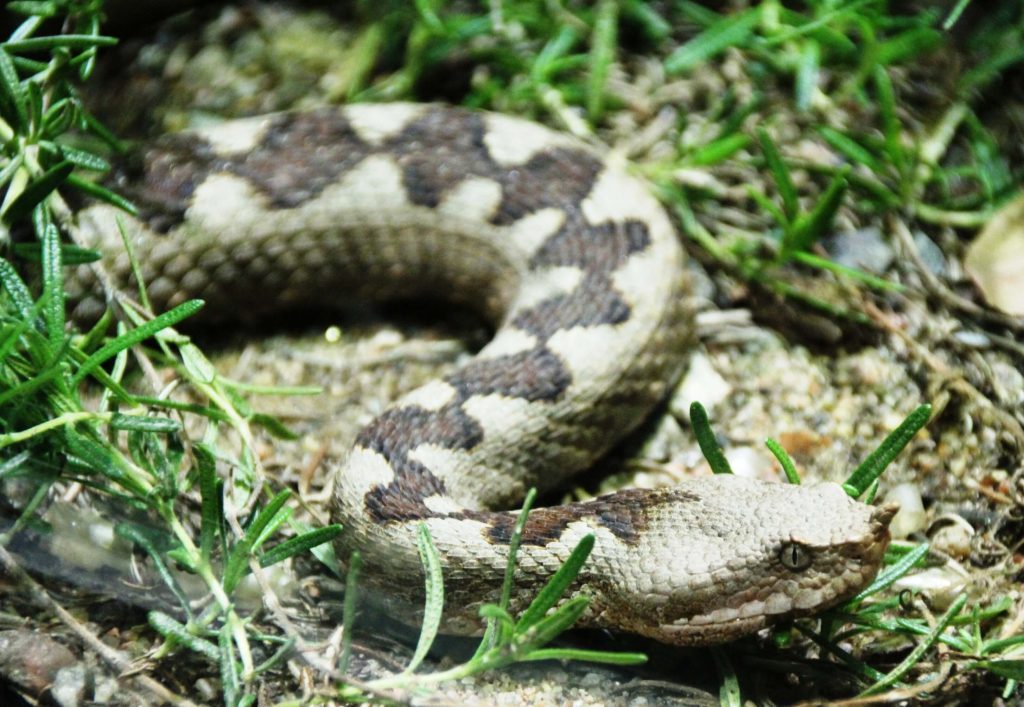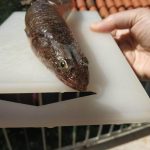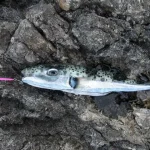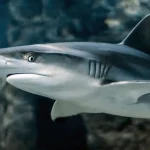Snakes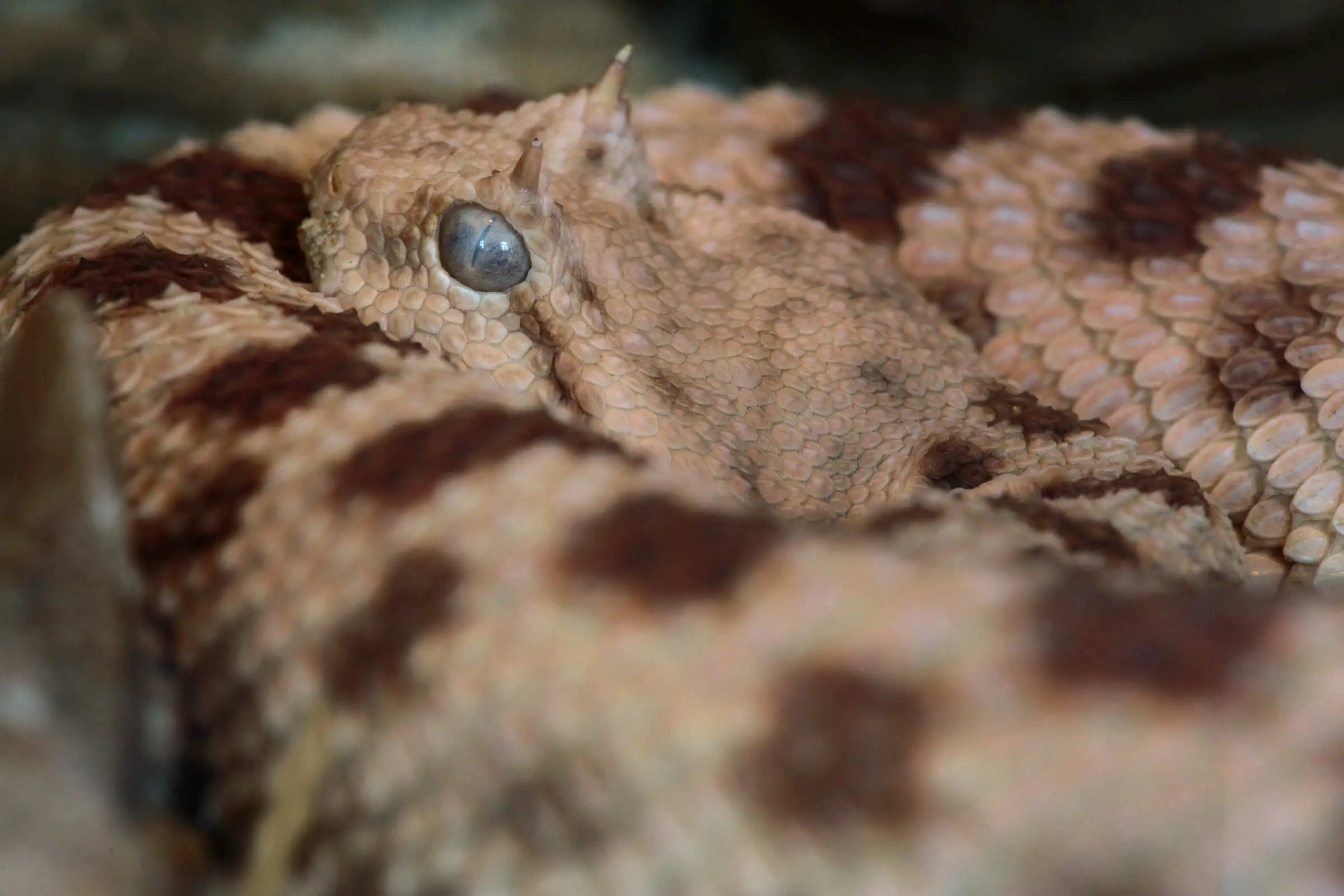
Photo credit: Mario Romulić
There are currently 15 snake species that are known to inhabit Croatia, and only 3 of them are venomous. Two of these venomous snakes – karst meadow viper and common European adder – are generally considered harmless since their venom have low potency and do not pose a serious threat to normal and healthy humans. However, the horned viper has been linked to 4 fatal deaths in Croatia. Although these vipers exist throughout the country, they are mostly found in the coastal cities and stony mountains of Dalmatia. They can be identified by the distinctive zigzag pattern on their backs. The horned viper, locally known as poskok, has a horn on its snout where its name was derived from. Its body is usually gray, sometimes pinkish-grey, with a dark grey/black zigzag pattern from head to tail. Horned vipers are usually quiet but will attack when provoked. These snakes have also been reported to have the ability to jump at a distance of 5 feet and as high as 3 feet. On the other hand, the common European adders are mostly found on meadows and freshwater and river lowlands of the Sava, Drava, Mura and Danube. They are also found in mountainous areas such as Gorski Kotor. Meanwhile, the karst meadow vipers prefer higher altitudes so they are mostly found in the mountains of Dinara and Velebit.
What to do when you encounter a snake? Slowly back away from the creature – do not attempt to catch the snake or chase it away. It is also best to avoid tall grassy areas and if passing through one is unavoidable, wear sensible and protective footgear. Never stick your arms or legs into unknown, dark and hollow spaces or any rock, leaf and wood piles – these are snake’s favourite hiding places! Lastly, always pay attention to your surroundings when climbing and hiking. For suspected snake bites, try to keep as still and calm as possible – a higher heart rate could cause the venom to spread faster. Tie a tourniquet from the bite towards the heart to delay the circulation of venom and seek medical assistance immediately!
Bears Photo credit: By Marshmallow – https://www.flickr.com/photos/tmarschner/2728816091/, CC BY 2.0, https://commons.wikimedia.org/w/index.php?curid=7080486
Photo credit: By Marshmallow – https://www.flickr.com/photos/tmarschner/2728816091/, CC BY 2.0, https://commons.wikimedia.org/w/index.php?curid=7080486
Croatia is full of forests and mountains, therefore, it makes an ideal home for the Croatian brown bear. It is highly unlikely to encounter them in established tourist attractions in Croatia but the risk goes higher around the mountainous regions of Gorski Kotar, Velebit, Lika, and even in the Biokovo and Mosor mountains of Dalmatia. Bears usually mind their own business and avoid humans, however, a mother bear with her cubs tends to attack any potential threats, even unprovoked. Nevertheless, only 3 bear attacks on humans in Croatia have been reported and all of them were non-fatal.
To avoid accidentally encountering a bear, Ivor Kocelj, an official tour guide in Croatia suggests that during a hike, talking, listening to music, or even clapping allow bears to notice the human presence and flee in advance. If a bear is spotted from a distance and looked unprovoked, you may continue to observe it, in silence. If the bear is within close proximity, try to calm down, retreat in silence, avoid eye contact and wait for the bear to leave. Bears are attracted to food so minimize bringing food with a strong odour and store them properly. Also, never come close to a bear cub because mother bears are extremely protective. Lastly, ALWAYS follow the marked hiking trails – let the wild animals live undisturbed in their habitat!
Black Widow Spider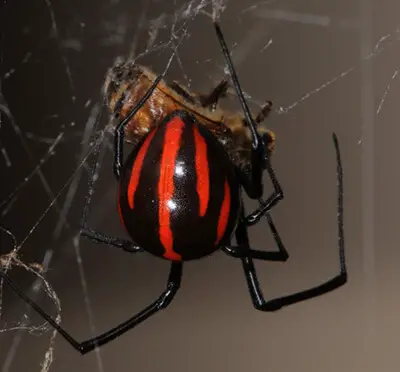 Photo credit: By Camazine – Own work, CC BY 3.0, https://commons.wikimedia.org/w/index.php?curid=4809805
Photo credit: By Camazine – Own work, CC BY 3.0, https://commons.wikimedia.org/w/index.php?curid=4809805
It is the most poisonous spider in Europe and is characterized by the distinctive red spots against its black back. In Croatia, they are found in the coastal areas of Istria, Dalmatia and Primorje. The spider’s bite is reportedly almost painless with symptoms appearing a few hours later which can include spasms, immense pain and sometimes, paralysis. Even though the venom is poisonous, most healthy adults would not suffer any fatal effects but the children, the elderly and people with weakened immune systems are highly susceptible. Black widow spiders often live in bushes, under rocks and grassy areas so the reported cases of spider bites are usually from people who accidentally stepped on them while walking barefoot. Hence, it is always advisable to wear proper footwear when outdoors. For any suspected black widow spider bites, seek prompt medical assistance.
Scorpions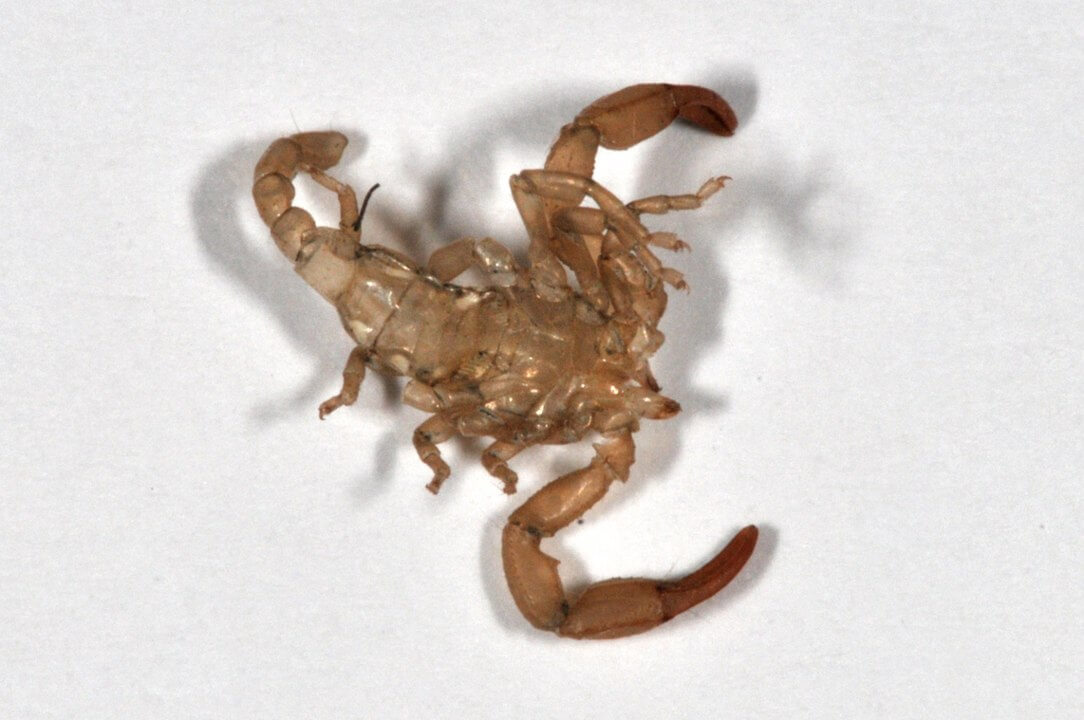 Photo credit: By Fritz Geller-Grimm – Vlastito djelo, CC BY-SA 3.0, https://commons.wikimedia.org/w/index.php?curid=9854317
Photo credit: By Fritz Geller-Grimm – Vlastito djelo, CC BY-SA 3.0, https://commons.wikimedia.org/w/index.php?curid=9854317
Few scorpion species are found in Croatia but the two most common species are the Euroscorpius Italicus and E. Germanus both of which are relatively harmless. Scorpions do not pose a serious threat to humans, however, a scorpion’s venom may cause swelling, redness and itching around the area. The person may also experience severe pain, allergic reactions, tingling and numbness. These arachnids are mostly found in coastal, rather than continental, regions of Croatia. If stung by a scorpion, it is best to apply a cool compress on the affected area and a pain relief medication if needed. To be safe, have the bite checked by a medical professional, especially if it is on a child. Take note: scorpions are protected species in Croatia so do not kill them if you spot one!
Ticks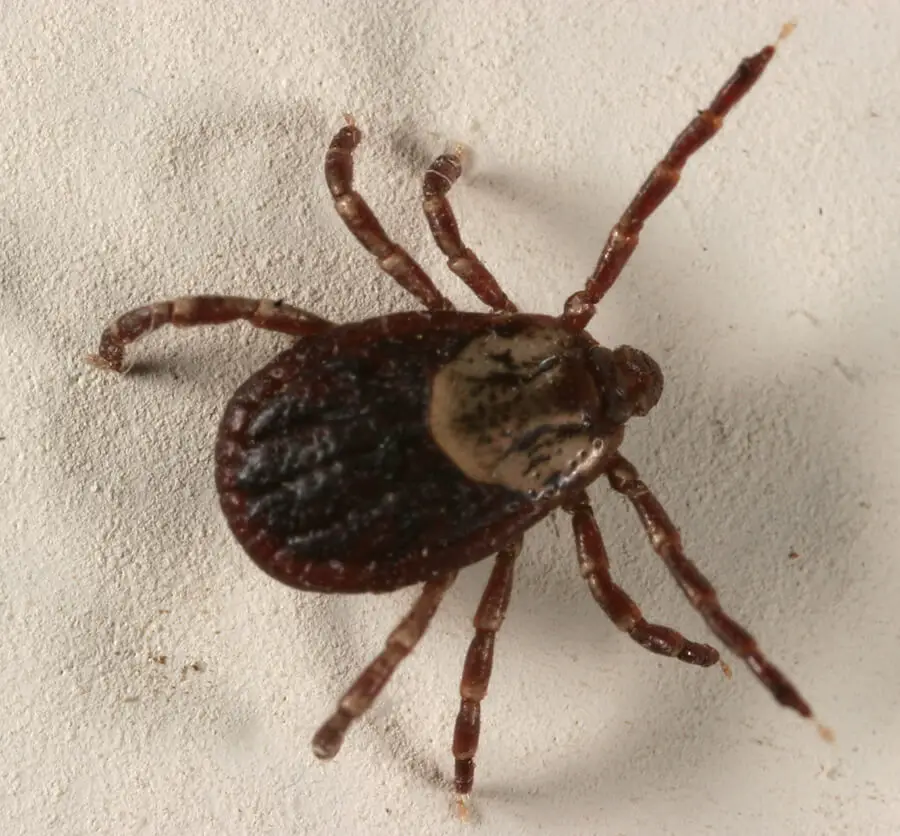 Photo credit: By André Karwath aka Aka – Own work, CC BY-SA 2.5, https://commons.wikimedia.org/w/index.php?curid=131004
Photo credit: By André Karwath aka Aka – Own work, CC BY-SA 2.5, https://commons.wikimedia.org/w/index.php?curid=131004
Ticks love wooded and grassy areas, as well as humid and warm environment – therefore, ticks can be found almost anywhere during spring and summer in Croatia. Most ticks in southern region of Croatia do not carry tick-borne illnesses. The ones who may transmit or cause infections such as Lyme disease, encephalitis and tick paralysis are active in May and June and are mostly found in forested regions of continental Croatia. To avoid getting bitten by these blood-sucking insects, it is best to wear full-length clothing and insect repellent especially during outdoor trips. If bitten and a tick is attached to your skin, grasp the tick as close to the skin’s surface as possible and pull it upward steadily using fine-tipped tweezers to safely remove the tick. Make sure not to leave any parts of the tick in your skin and clean the bite area, as well as your hands, with soap and water and rubbing alcohol. Remember to never crush a tick with your bare hands as it may transmit diseases. It is best to dispose a live tick in alcohol solution, place it in sealed container or flushing it down the toilet.
Sharks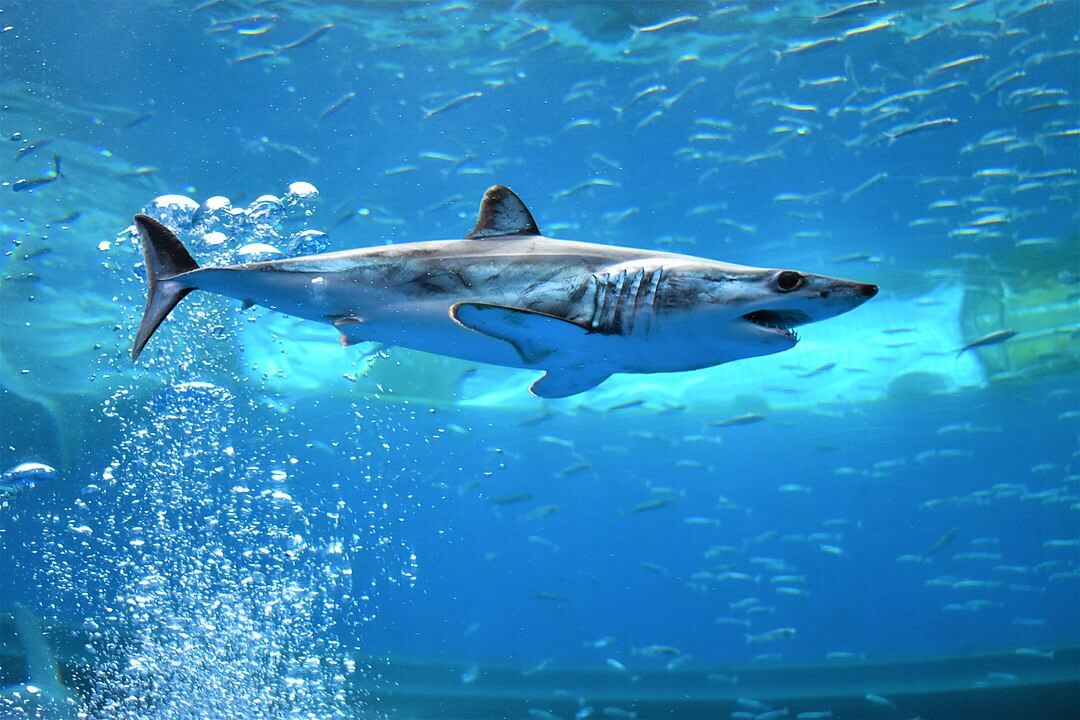 Photo credit: By 出羽雀台 – Own work, CC BY-SA 4.0, https://commons.wikimedia.org/w/index.php?curid=107209573
Photo credit: By 出羽雀台 – Own work, CC BY-SA 4.0, https://commons.wikimedia.org/w/index.php?curid=107209573
With rich marine biodiversity, numerous species of sharks are found in the Adriatic waters with only two species – Mako and Great White sharks – are deemed dangerous to humans. According to Shark Attack Data, since the 1900s, there have been 11 reported fatal shark attacks in Croatia – the latest of which took place in 1974 in Omiš. The last recorded non-fatal shark attack was in 2008 near Vis Island. Nonetheless, the attacks in the Adriatic sea are extremely rare so it is still very safe for swimmers, surfers and divers.
The best way to avoid a shark attack is to take extra precautions when going to the sea. For starters, avoid swimming too far away from the coastline and do not wear bright jewellery because sharks might confuse it for a glistening fish, a.k.a, shark food. If a shark happens to be nearby, try not to panic and swim away vertically without making too much movements and noise. If a shark ends up attacking you and you are not alone, it is best to stay in a defensive position (back-to-back) to avoid surprise lunges from sharks. It is impossible to outswim a shark so your best bet is to make the shark see you as a strong and credible threat by throwing a jab at the shark’s most vulnerable areas – gills, eyes and snout. Targeting these areas can cause the shark to retreat. Sharks rarely attack but when they do, it can be severely dangerous, even fatal; so the surest way to prevent shark-related incidence is to steer clear from shark-infested areas.
Sea Urchins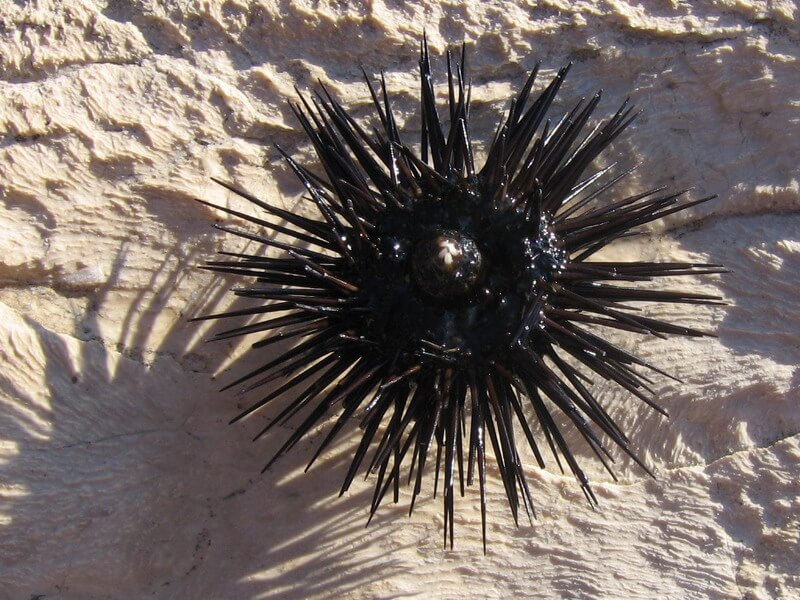 Photo credit: By Lacen – Croatia, Public Domain, https://commons.wikimedia.org/w/index.php?curid=248760
Photo credit: By Lacen – Croatia, Public Domain, https://commons.wikimedia.org/w/index.php?curid=248760
The presence of sea urchins is a sign of clean and unpolluted water, hence, it’s no wonder that these spiky creatures are ubiquitous on the Adriatic Coast. Every tourist season, the public beaches in Croatia are often cleaned of sea urchins so most of them are found in secluded and natural beaches near the shores and around the rocks. Sea urchins are not poisonous but stepping on their spikes cause painful foot injury which can make the rest of your trip irritating and uncomfortable. Their spikes break easily and worse, they get stuck under the skin. The best way to prevent a sea urchin injury is to wear a pair of protective water shoes (warning: may trigger strong disapproval look from locals). If you accidentally stepped on a sea urchin, use tweezers to remove any spikes, although some will be too deep to be taken out. Afterwards, clean the affected area with soap and water but remember to leave it open and unbandaged. Use pain relievers if needed.
Jellyfish & Sea Anemone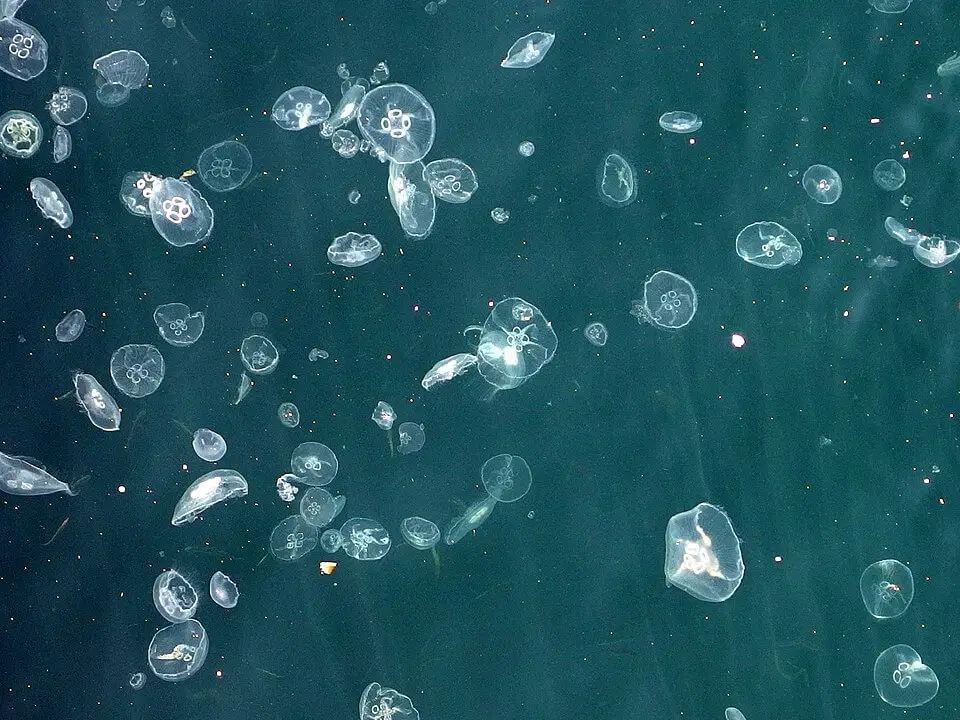 Photo credit: By Mark Ahsmann – Own work, CC BY-SA 3.0, https://commons.wikimedia.org/w/index.php?curid=30241025
Photo credit: By Mark Ahsmann – Own work, CC BY-SA 3.0, https://commons.wikimedia.org/w/index.php?curid=30241025
Jellyfish are gelatinous sea creatures mostly made up of water, thus, they do not have good movement control. These creatures mostly float and are carried by sea currents so their presence is detected from time to time in the Adriatic sea. Unfortunately, when jellyfish end up in Adriatic coast, they come in huge numbers so jellyfish related injuries go up as well. However, most of the stinging incidents occur when a human accidentally brushes across a jellyfish while swimming. The jellyfish that are found in the Adriatic sea come from cnidarian family of which contain a number of species that are poisonous. The long tentacles of jellyfish are able to pierce through human tissue where their poison is transferred. Sea anemones are also found in the Adriatic shores, especially, the cylinder anemone. This type of anemone is often found in shallow waters and unlike jellyfish, sea anemones are sedentary and are attached to seabeds and rocks where humans can easily step on them.
A jellyfish and anemone sting may cause searing pain or severe burning sensation in the affected area and redness and rashes may also appear. Sometimes, the area swells and gets blistered, too. Some people have been reported to develop severe symptoms including eczema, violent itching, and darkened skin pigmentation. In very rare cases, jellyfish venom can lead to anaphylactic shock causing serious health risks. Depending on the severity of the situation, the first aid for a jellyfish sting is to wash it with salt water (freshwater can intensify the pain), and wash the injured area with vinegar or alcohol because these can block the poison from releasing further. There are also medications that reduce swelling and itching but the best treatment option is to get the injured area checked by a medical professional.
Important note: Dead jellyfish can still sting so never touch one with bare hands!
Weever Fish 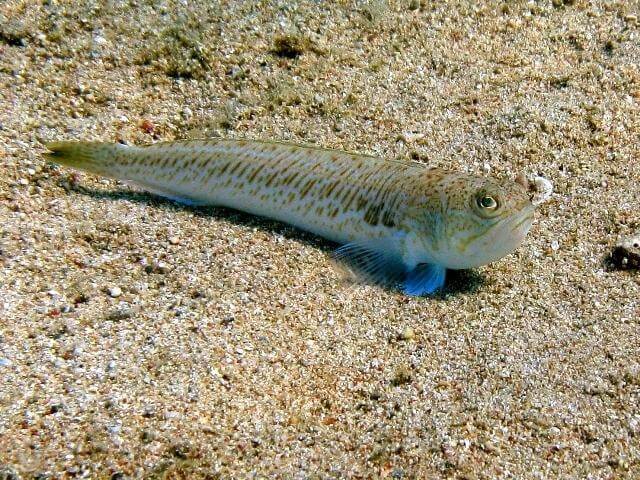 Photo credit: By Roberto Pillon – http://www.fishbase.de/photos/thumbnailssummary.php?ID=1363#, CC BY 3.0, https://commons.wikimedia.org/w/index.php?curid=25931842
Photo credit: By Roberto Pillon – http://www.fishbase.de/photos/thumbnailssummary.php?ID=1363#, CC BY 3.0, https://commons.wikimedia.org/w/index.php?curid=25931842
The greater weever, locally known as pauk, is the most commonly found weever fish in the Adriatic sea. Other species from this family include starry weever, lesser weever and spotted weever, all of which are very rarely found since they prefer deeper areas and only approach the shores during mating season in winter. The greater weever poses the biggest hazard to humans because they often swim in shallow waters. The weevers have spikes on their gills and dorsal fins where their poison is located. Most incidents including greater weevers happen due to fishermen’s carelessness and lack of knowledge or when a swimmer steps on the fish accidentally in the shallow waters. The venom of weever fish brings unbearable pain within 15 to 30 minutes of contact and swelling. The most common reactions to weever venom include loss of consciousness, nausea, loss of sensation in the affected area, elevated heart rate and breathing difficulties. The first aid for weever fish poisoning starts with removing the remaining spikes and disinfecting the area with clean water and soap. Afterwards, soak the area at the highest temperature one can endure for at least half an hour while being careful not to cause burns on the skin. Poison from weever fish is believed to be volatile in heat so this step is highly advisable to delay the spread of the poison until medical help arrives.
In general, the diverse and beautiful Croatian wildlife is very safe as long as you keep proper distance and safety measures from the wild animals. It is highly unlikely for you to come across these wildlife dangers, except maybe for sea urchins, but it is always best to stay alert and observe necessary precautions when travelling in unfamiliar places. Get acquainted with the list of numbers and responders in Croatia you may need to contact in case of emergency. Have a safe travel and remember, watch where you step!
For more on travel, follow TCN’s dedicated page.
For Croatia’s best travel destinations and trips, follow Total Croatia.
CLICK HERE for more about Croatia.

